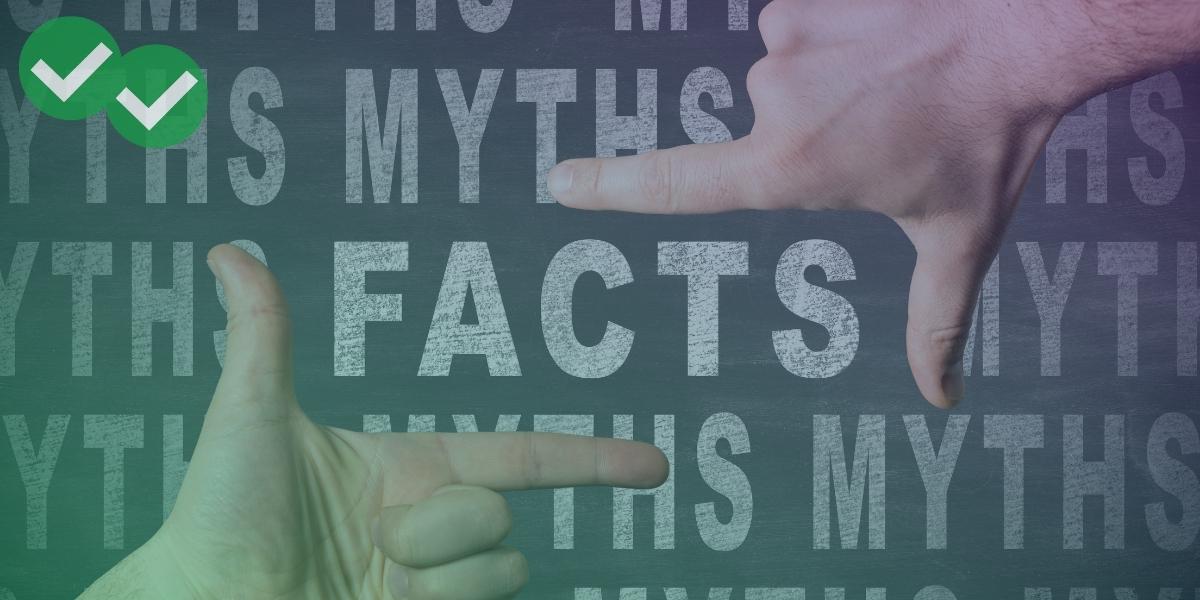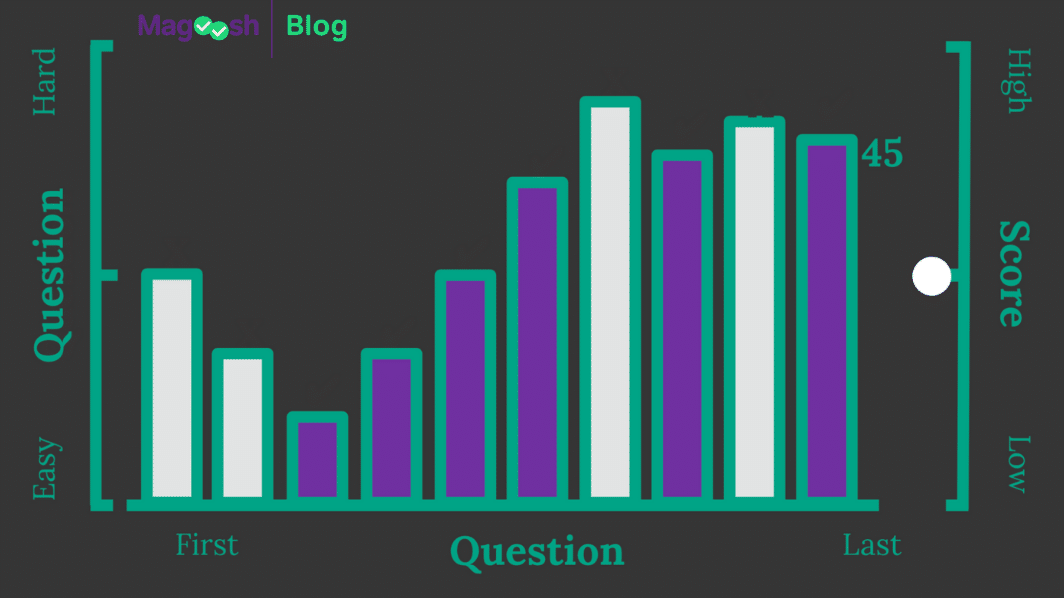
The GMAT Exam is a well-known, even legendary, part of the business school application process! But for every legend, we can hear some mythical tales. Some of the common GMAT myths you may have heard aren’t quite consistent with fact, though. Wrong information can have a negative affect on your preparation and your test score.
So let’s examine a few popular GMAT myths and dig into the truth behind them. Most importantly, we’ll discuss how a good understanding of the facts can shape your strategies and help you get the GMAT score you need. The video below also breaks down the same facts and myths, featuring Eric Chambers from GMAC and Erika from Magoosh!
GMAT Myth #1: The First 5-10 Questions Are the Most Important
Why the Myth Exists
The GMAT is a computer-adaptive exam. That’s a rare and special exam type. It can be hard to understand what that really means, so there are many misunderstandings out there (you should note that not all computer-adaptive exams are created equal, either). The exam does determine the difficulty level of the question it’s going to give you next based on your performance so far in the section. And so some people think it’s crucial to get the first few questions correct, or else you can’t get a good score.
Myth Status: BUSTED!
The fact is: the first five or 10 questions are not more important than the rest because the test is computer-adaptive. If you get a question wrong early on, that will affect the difficulty of the next question you are given. But if you answer that following question correctly, then you will be back on track to increasing your score. The exam is constantly trying to adjust the difficulty of questions to figure out what you can and can’t get right. So your score is based on your performance throughout the section, not just on the first five to 10 questions.
If you spend too much time working on the earlier part of the section, you might find that you run out of time to complete the section–and that could have a bigger negative impact on your score than missing a few early questions would! If you feel yourself starting to run out of time, that can increase your stress level and affect your performance on all the remaining questions in that section.
The Takeaway
You should do as well as you can on the first five to 10 questions while working at a reasonable exam pace that allows you to answer all the questions in the section before time runs out–the same way you should on all of the questions.
GMAT Myth #2: You Need to Get Every Question Right for a High Score
Why the Myth Exists
Many exams calculate your final score based on the number of questions you answer correctly. So it’s normal for students to focus on the percentage of questions they answer correctly when studying for a test.
Myth Status: FALSE!
This is another myth that is not true because the test is computer-adaptive. The GMAT’s complicated algorithm is working to calculate your score every time you answer a question. That score is based on the difficulty level of each question and your response. Because of that adaptive difficulty, two students could get the same number of questions right and get very different scores.
The test’s goal is to identify the difficulty level that matches your ability–and when it’s gotten close, you may see an alternating pattern of right and wrong answers as the exam makes small adjustments in difficulty from one question to the next. Even the highest scorers will get some questions wrong or even have to skip a question and move on. That is not a sign that you are doing poorly, and you should not let it affect your confidence.
To help us visualize GMAT myths #1 and #2 in practice, this graph represents a hypothetical sequence of questions within one GMAT section.

The first question given is at a medium difficulty, and I get it wrong (white bar). The next question is at a lower difficulty, and that one is also answered incorrectly. For many students, this is a disaster! The first two are wrong. My accuracy is 0% so far. I can feel the questions getting easier [more on that myth later] and I know I’m bombing the exam. Now I’m at a key crossroads: am I going to let GMAT stress get the best of me, or will I keep those emotions in control and keep doing my best?
Now, let’s assume I keep my composure and get the next question right (purple bar)! The next four, in fact. I’m getting into a good rhythm now. Notice that the difficulty level is increasing each time I get a question right. Then, eventually, there’s a question with a significantly higher difficulty and I get it wrong. The next question I see will be a little easier–but only by a little. At this point, the test is closer to estimating my personal score level. I fall into a pattern of alternating right and wrong answers, and the changes in difficulty level get narrower and narrower with each question.
Let’s notice a few key points from the graph:
- We got the first two questions wrong and that was OK.
- Our accuracy for this batch of 10 questions was only 60%.
- Because of the adaptive exam, my raw score is sitting at a 45 out of 51, a very respectable score on either Quant or Verbal!
The Takeaway
Do not get discouraged on test day if you’re getting some questions wrong! Your score is about difficulty, not percentages. In fact, if you find the questions challenging but mostly doable, then you are probably performing at the right level for your ability.
GMAT Myth #3: Studying Hard Questions is The Only Way to Improve Your Score
Why the Myth Exists
If the test is giving you harder questions and you’re getting them right, then your score is improving, right? So by extension… we need to get the hardest questions right, don’t we? Some students, then, prefer to study only hard and very hard difficulty questions in the hopes of getting a top score.
Myth Status: BAD IDEA!
In reality, many students never even see the hardest difficulty questions on test day. You will not be given high-difficulty questions if you haven’t been answering low- and medium-difficulty questions correctly. So focusing your studies on those high-level questions could be a waste of time if your skills on easier questions are lacking. And working on only the hardest questions all the time could lead to frustration and discouragement. That will not help you progress!
Instead, it’s best to identify your personal weaknesses and work on those. That could include gaps in your knowledge, needing to build strategies for challenging question types, improving pacing, or learning to recognize and avoid trap answer choices. One great way to identify your strengths and weaknesses is to keep a GMAT error log while you are studying and practicing. Find the lower-difficulty questions that you are struggling with, and study the skills you need to improve those. Then, move the difficulty level at which you’re working up little by little as you improve.
The Takeaway
Instead of studying questions that are difficult for people in general, work on topics and question types that are weak spots for you as an individual. Look for categories of questions that you can get right about 50% of the time, and work on improving those areas. That will help you increase your overall performance level, and you can adjust as your skills increase over time.
GMAT Myth #4: Getting an Easy Question Means The Previous Question Was Wrong
Why the Myth Exists
The GMAT is a computer-adaptive exam. Are you getting tired of hearing that by now? In general, that means the test chooses the difficulty level of the next question based on the questions you’ve answered correctly and incorrectly so far.
Myth Status: Kind of true, but… SO WHAT?
A wrong answer is definitely one reason you may find that the next question is easier. It’s probably the most common reason you’d get an easier question. But is that knowledge helpful?
Can you do anything about it? Nope! With the GMAT format, there’s no going back. So what’s done is done. You have no control over the questions you’ve already answered, right or wrong.
Can recognizing a question is easier harm you? Absolutely! It can be upsetting. It can take your attention away from the next question and affect your pace. Can it help you? Not really. At most, it would tell you that you should really try to get the next question right if you reasonably can. And that’s true anyway, regardless of your answer to the last question.
Does an easier question always mean that you got a question wrong? No, yet again. You might think a question has an easier difficulty level when really the test ranks it at the same or higher difficulty. It might just feel easier to you because of your personal knowledge and skills. Or, in some cases, the exam may be adding additional unscored questions to your section so they can try them out for future exams.
The Takeaway
Paying attention to whether a question “feels” easier or harder cannot help you, but it can cause a lot of harm. So the course of wisdom is to continue doing your best on the remaining questions on the exam, no matter what has happened up to that point. Try not to let the mental toll of guessing your score distract you from the question in front of you.
GMAT Myth #5: Verbal and Quant Scores Mean the Same Thing
Why the Myth Exists
Both the Verbal and Quantitative sections give you a raw score between six and 51. Since the score ranges are the same, it would make sense that they mean the same thing. So, for example, does a score of 41 out of 51 on Quant mean the same as a 41 out of 51 on Verbal?
Myth Status: DEFINITELY NOT!
While this is a very reasonable misunderstanding, it’s not accurate. In reality, raw scores on average are much higher for Quant than for Verbal. The difference is more significant than you may realize. So there is no direct way to compare raw scores between the two sections.
Here’s a comparison of the mean average GMAT scores for each section.
| Section | Mean Score |
|---|---|
| Verbal | 27.51 |
| Quantitative | 41.3 |
| Integrated Reasoning (IR) | 4.65 |
| Total Score | 574.51 |
Sample Size: 414,618
Standard Deviation: 113.07
Data Period: January 2019 -December 2021
The major piece of information we should notice here is the actual mean score. On a scale of 6 to 51, you are doing an “average” job if you get about a 41 in Quant and about a 27 in Verbal. That’s a huge difference!
Let’s look at this from another angle. Each raw score is paired with a GMAT percentile ranking. That tells you what percentage of test takers scored lower than that raw score. You can and should compare percentiles directly between sections. That tells you how well you’ve scored compared to everyone who takes the exam.
Back to our hypothetical question: does a score of 41 out of 51 on Quant mean the same as a 41 out of 51 on Verbal? Not even close! According to data complied from 2018-2020 (source: GMAC), a score of 41 on the Quant puts you at the 37th percentile, so you have done better than about a third of other test-takers. By contrast, a 41 in Verbal is at the 94th percentile. That’s incredibly high! You’re in the top five to six percent of all GMAT Verbal scores.
The Takeaway
Comparing your raw Verbal and Quant scores is not comparing apples to apples. There is no direct relationship between those numbers. A much better option is to compare percentiles. Raw scores are just a tool used to calculate your final score, but it’s really your GMAT scaled scores and the percentile rankings with which they correspond that matter.
GMAT Myth #6: GMAT Requires Advanced Math Knowledge
Why the Myth Exists
The GMAT is an exam for university students or graduates, so many assume it requires college-level math skills. Additionally, some who study for the exam come across concepts they haven’t learned during their personal math journey.
Myth Status: FALSE
There are definitely some math topics that you need to learn and study for the exam. But most of them only require a high-school level knowledge of the subject. Sometimes the things you’re studying while preparing for the GMAT seem new, but that’s usually because either you haven’t seen and used them in a very long time or there was a gap in your knowledge of that concept when you were in school. A basic working knowledge of arithmetic, algebra, and geometry and a little bit of statistics is a really good foundation for success on the Quant section. Some topics are more advanced than others, like probability and counting methods, but those subjects appear in a relatively small number of questions.
Don’t get me wrong–the GMAT Quant section can feel a lot more complicated than high school math classes! One reason is that many of the concepts are presented in word problems, so we have to add a reading comprehension element to our math experience.
When the test increases the difficulty of a question, though, it often does that by adding layers of complexity. So the topic itself isn’t more advanced, but you may have to perform several steps to find the answer instead of just one or two. Or you have to sort through more information than you need to identify the useful facts.
Another note: you can’t use a calculator on the GMAT Quant section. This can make it feel like you need to be advanced in your math skills to make the right calculations. In reality, though, we usually learn those arithmetic skills when we’re fairly young. Many of us don’t use them as we grow up and so those skills fade. The good news is: whenever a test doesn’t allow a calculator, that means they must choose fairly simple numbers for students to work with. The calculations themselves cannot and will not be elaborate.
The Takeaway
The GMAT is not interested in your ability to perform elaborate mathematical calculations. It’s more interested in your ability to apply logic, reasoning, and problem solving skills. The Quant section does require some mathematical knowledge, but the test is primarily concerned with the way you apply that knowledge to exam problems. You should expect that a review of common high-school level math topics–combined with common sense and problem-solving techniques–will help you score the majority of the points.
GMAT Myth #7: A High Score is the Only Way to Get Into Your Desired Business School
Why the Myth Exists
Your GMAT score and your undergraduate GPA probably seem like the easiest parts of your admissions process to judge because they have numbers assigned. When evaluating your chance of being accepted, it’s natural to want some standard against which to compare yourself. So we may tend to choose what schools we think we can get into based on the average scores of students accepted.
Myth Status: DON’T LIMIT YOURSELF!
Like it or not, the admissions process is more complex than simply earning a certain GMAT score. In reality, admissions departments are looking at many parts of your application when deciding if you’re the right fit for that school or program. Your GMAT score, GPA, and coursework are definitely factors. But so is your personal background and situation. The goal of the admissions department is to predict which students are most likely to succeed within the program. Test scores can predict success to some degree, but they don’t tell the whole story.
Here’s an important fact: Average test scores are just that–averages. So if you are looking at the average GMAT scores of students admitted to a school, please remember that only some of the students got that score. Many scored higher, and many scored lower. That’s how averages work. A more accurate way to compare your score with candidates in that school or program is to find out the range of GMAT scores of those who were accepted rather than the average. The admissions department may be happy to give you that information if you ask!
It’s a good idea to get an idea of what score you will need in order to be a competitive applicant. And when you can successfully reach that goal, then you should be pleased with that! Trying to get the highest possible score can actually feel overwhelming and make it hard for you to commit to your GMAT preparation. If you have a specific goal in mind, that can help you stay motivated and find satisfaction in the progress you make.
The Takeaway
Please, do not rule yourself out from applying to a school or program just based on your GMAT score. Your score, combined with your education history and personal circumstances, might work together to make you the perfect fit.
GMAT Myth #8: The GMAT Is Harder Than the GRE
Why the Myth Exists
This one probably originates with some people expressing their personal opinions. Maybe the question types on the GMAT seem harder for some. And the adaptive nature of the exam can make it feel mysterious and intimidating.
Myth Status: IT DEPENDS
The GMAT is definitely more difficult for some students, and the GRE is harder for others. Some of the question styles do vary between exams. Some do well on an exam like the GRE which allows you to skip questions and come back, and others find that makes them overthink and second-guess their answers. Which exam is “easier” really depends on you.
Do you have the opportunity to choose between the GMAT and GRE? Many schools are accepting both for admissions now. Take some time to research the testing requirements of the schools and programs you plan to apply for. You may also find that the field of study you’re pursuing prefers one exam over the other.
If you learn that either exam will meet your needs, then you should find out which one is easier for you! The best way to do that is to take a full-length practice GRE and a full-length practice GMAT. If possible, each one should be done in a quiet environment with minimal distractions and timed accurately. Once you have your scores, compare your percentile rankings to see which score is higher–or maybe they’re about the same. Reflect on your percentiles and the experience of taking each exam, and you should be able to tell which one was easier for you.
The Takeaway
Which test is harder varies from person to person. The best way to identify which one you find easier is to try them both.
Final Thoughts
There are many GMAT myths in existence. Some are based in fact and others are distortions of those facts. But many of them could hold you back from getting your best test score if they affect your strategy. So don’t be intimidated if you hear rumors that make the test sound scary.
Instead, try to get accurate information about the exam. Practice with high-quality materials. And build strategies that help you to overcome your personal weaknesses. Then you will be well on your way to getting the test score you need and working toward your future goals!






Leave a Reply